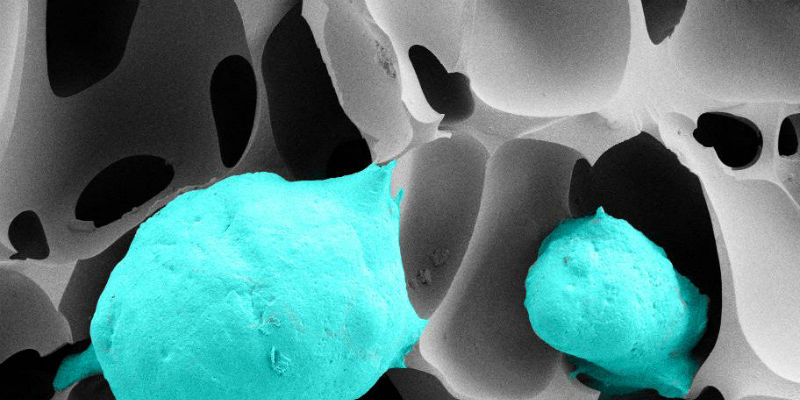A team of researchers at Karlsruhe Institute of Technology (KIT) in Germany are developing a three-dimensional model for prostate cancer research based on cryogels. The model will be used to reproduce natural processes and above all to examine the development and the progression of tumors.
A current paper on the project published in the scientific journal Small, which deals with micro and nano sciences, has been crowned top story of the week by Prostate Cell News, a major international platform and database for prostate cancer research.
In the western world, prostate cancer is the most common malignant tumor in men. Fundamental research is facing the challenge of examining the progression of the disease from the trigger to the formation of metastases, and particularly of understanding the interaction of cancer cells with their environment.

Taken with a scanning electron microscope, prostate cancer cells (green) in a superporous cryogel with tissue-like elasticity. (Credit: Bettina Göppert/KIT)
The group headed by Dr. Friederike J. Gruhl at the Institute of Microstructure Technology is working closely with Professor Andrew C. B. Cato at KIT’s Institute of Toxicology and Genetics (ITG) to develop a biomimetic system, a cell culture model for recreating human prostate cancer in vitro.
Cryogels are used as the base material. In this case, they are made of synthetic polymers which can be put together to form three-dimensional porous structures due to the formation of ice crystals from trapped water. The mechanical properties of these structures are very similar to those of natural cell tissue.
Since October 2012, the state of Baden-Württemberg has been funding the “Development of a 3D Prostate Model for Cancer Research” project with €200,000 ($273,000 ), which is part of the “Development of Alternative Methods to Avoid Animal Experiments” program.
The paper published in Small, “Superporous Poly(ethylene glycol) Diacrylate Cryogel with a Defined Elastic Modulus for Prostate Cancer Cell Research,” outlines results from a dissertation by Bettina Göppert’s, a doctoral candidate at KIT’s microstructure technology institute.
It was created in collaboration with the Cato team and with the help of methods that were developed at the Institute of Functional Interfaces and the ANKA Synchrotron Radiation Source researchers.
“The paper covers the implementation of the model and shows that it is a long-term stable tissue-like 3D cell culture system, with the help of which hormone-independent prostate-specific gene expression could not only be achieved, but even be reinforced compared to conventional 2D models,” Gruhl said. It was shown by the cultivation of androgen-sensitive prostate cancer cells.
In future, it may be possible to cultivate both healthy cells of the prostate tissue and cancer cells in the 3D cryogel model, according to the researchers, who added that this may open up new opportunities for preclinical research and for using it in the clinical development of anti-prostate cancer drugs.
